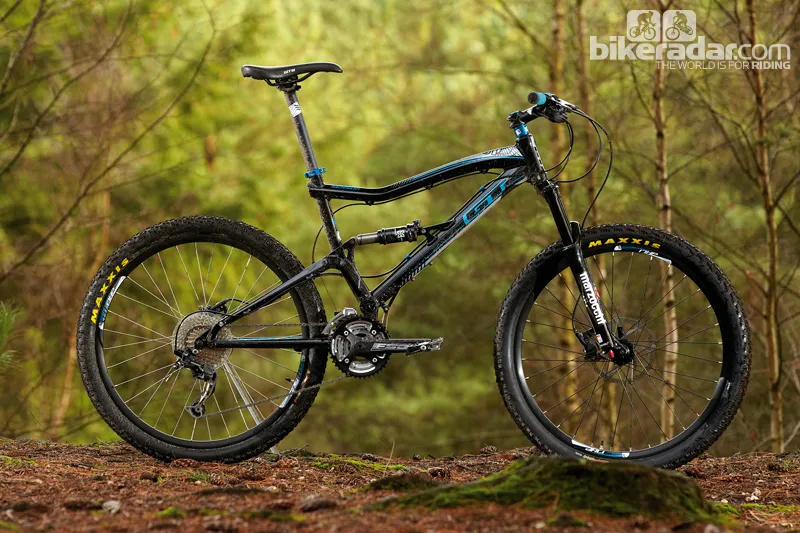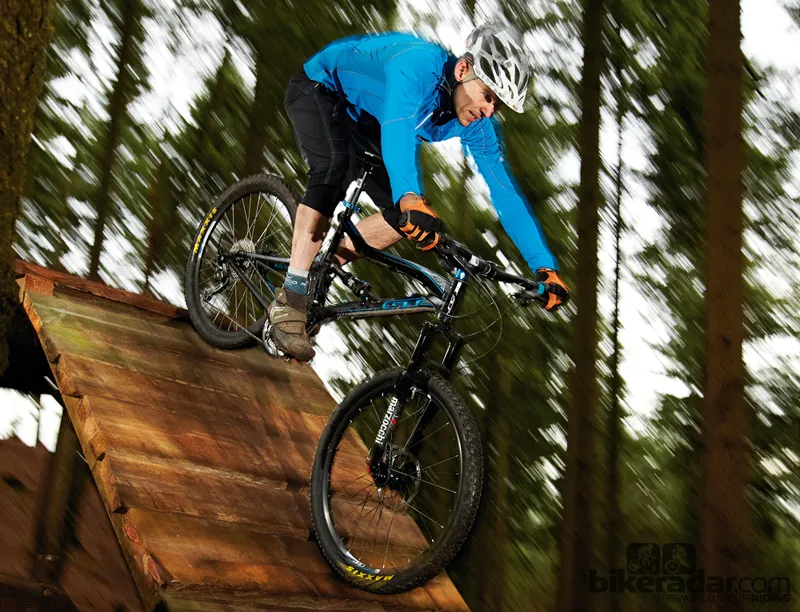2012 marks the third year for GT's 120mm-travel Sensor. Despite its 31.3lb (14.2kg) heft, the 3.0 isn't the big hitter that you might expect – while its stubborn shock is more at home with more substantial impacts, the bike's geometry and tyres don't necessarily push you to seek them out.
Ride & handling: Agile, but lazy rear shock dulls responses
GT's Independent Drivetrain rear suspension system, which moves the bottom bracket to counter excess chain growth, has been around for a long time and is a proven performer. The Sensor 3.0, though, suffers from excessive compression damping in the X-Fusion shock.
This not only blunts the back end's responses over bumps but also sucks a lot of life out of the bike. The reluctance of the rear to compress makes lofting the Sensor's front end harder than it ought to be, and the bike sits high in berms too. On the upside, there's little in the way of wallow from the back end and the Sensor never feels mushy.
The supple coil-sprung Marzocchi 44 fork is a great performer in isolation but it's tricky to achieve a balanced suspension performance with the compression-shy rear end. That said, start hitting things hard and fast and matters improve considerably. The shock is much happier dealing with bigger hits and the Sensor sucks up drops with aplomb, with GT's floating bottom bracket cleverness minimising pedal kickback.
The trick is to ride hard, while staying within the limits of the rather cross-countryish angles and shallow-tread Maxxis Aspen tyres. Thankfully, the relatively short cockpit means that there's plenty of scope to position your weight dynamically for optimum traction.
We know from past experience that the Sensor platform can work better than this, and even with a less than ideal suspension action the fundamental strengths of the bike show through. There's a well-judged whiff of pedal feedback – enough to maintain poise under power but not so much as to put you off your stride on steppy climbs. And the handling is good, although the current crop of slack and low trail bikes are easier to live with on fast, open trails.
Reluctant rear shock aside, there's not much wrong with the GT. But there's a definite sense of the competition having moved on a step and left the Sensor playing catch-up. The traditional geometry, slender back end and skinny head tube are all areas where the Sensor's beginning to show its age.
Frame: Lots of tyre clearance from the slimline swingarm, but there's a bit of flex in it
The Sensor platform has seen little change since its introduction for the 2010 model year. It's a distinctive frame, with a hump-backed top tube that's pierced by the seat tube – a GT trademark going back 20 years. At first glance the Sensor looks very high off the ground but that's an optical illusion due to the straight down tube joining the seat tube some distance above the bottom bracket.
That's to accommodate GT's Independent Drivetrain suspension system. The one-piece swingarm rotates on a single, high pivot to give a useful rearward axle path. Ordinarily that would result in considerable pedal feedback, so to counter that the bottom bracket itself swings slightly back on an additional linkage. Use of slimline tubing on the swingarm means pots of tyre clearance but a hint of twang under pressure.
The shock's position – high up and horizontal in the middle of the frame – keeps it out of harm's way but means the single bottle mount is relegated to a less-than-clean location under the down tube. Cable routing is remarkably direct thanks to that elevated down tube, with the rear brake hose and gear cable taking an almost straight line to their respective destinations.
Equipment: Outgunned on spec by similarly-priced competitors
At this pricepoint anything other than a RockShox Recon fork up front is worthy of comment, and GT have specced a Marzocchi 44 RLO. The Italian fork makers have had their ups and downs in recent years but the 44 is a bit of a gem. It's still tough to beat steel coil springs for bump-eating performance, and Marzocchi combine them with air preload for easy tuning.
Elsewhere it's all competent gear, although the FSA Gamma Drive chainset manages to somehow look a bit cheap despite being a modern outboard-bearing setup and working fine. We’ve no complaints about the 30-speed Shimano Deore transmission or Avid Elixir 1 brakes. The rest of the kit is mostly GT's own All Terra gear, including the rims and both hubs. We'd prefer at least a Shimano rear hub in the interests of longevity and spares availability, but didn't encounter any issues during the test period.

This article was originally published in Mountain Biking UK magazine.
